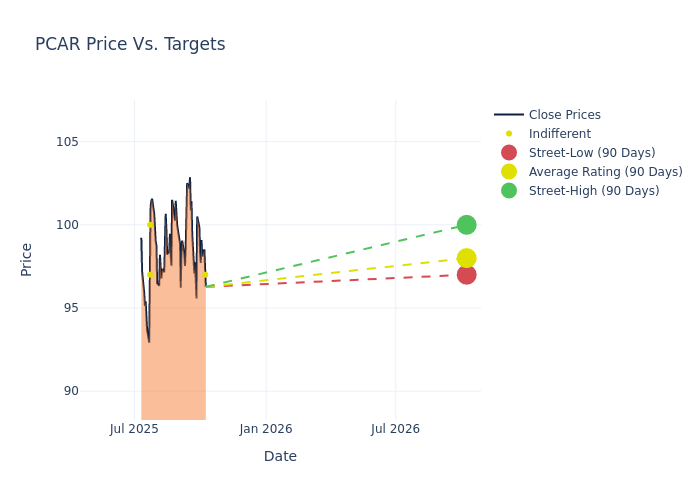4 Analysts Have This To Say About PACCAR
Author: Benzinga Insights | October 08, 2025 02:01pm
Across the recent three months, 4 analysts have shared their insights on PACCAR (NASDAQ:PCAR), expressing a variety of opinions spanning from bullish to bearish.
The table below provides a concise overview of recent ratings by analysts, offering insights into the changing sentiments over the past 30 days and drawing comparisons with the preceding months for a holistic perspective.
|
Bullish |
Somewhat Bullish |
Indifferent |
Somewhat Bearish |
Bearish |
| Total Ratings |
0 |
0 |
4 |
0 |
0 |
| Last 30D |
0 |
0 |
1 |
0 |
0 |
| 1M Ago |
0 |
0 |
0 |
0 |
0 |
| 2M Ago |
0 |
0 |
0 |
0 |
0 |
| 3M Ago |
0 |
0 |
3 |
0 |
0 |
In the assessment of 12-month price targets, analysts unveil insights for PACCAR, presenting an average target of $98.0, a high estimate of $100.00, and a low estimate of $97.00. This current average has increased by 4.26% from the previous average price target of $94.00.

Understanding Analyst Ratings: A Comprehensive Breakdown
The standing of PACCAR among financial experts becomes clear with a thorough analysis of recent analyst actions. The summary below outlines key analysts, their recent evaluations, and adjustments to ratings and price targets.
| Analyst |
Analyst Firm |
Action Taken |
Rating |
Current Price Target |
Prior Price Target |
| Jamie Cook |
Truist Securities |
Lowers |
Hold |
$97.00 |
$98.00 |
| Steven Fisher |
UBS |
Raises |
Neutral |
$100.00 |
$81.00 |
| Tami Zakaria |
JP Morgan |
Raises |
Neutral |
$97.00 |
$95.00 |
| Jamie Cook |
Truist Securities |
Lowers |
Hold |
$98.00 |
$102.00 |
Key Insights:
- Action Taken: Analysts frequently update their recommendations based on evolving market conditions and company performance. Whether they 'Maintain', 'Raise' or 'Lower' their stance, it reflects their reaction to recent developments related to PACCAR. This information provides a snapshot of how analysts perceive the current state of the company.
- Rating: Analysts unravel qualitative evaluations for stocks, ranging from 'Outperform' to 'Underperform'. These ratings offer insights into expectations for the relative performance of PACCAR compared to the broader market.
- Price Targets: Gaining insights, analysts provide estimates for the future value of PACCAR's stock. This comparison reveals trends in analysts' expectations over time.
Analyzing these analyst evaluations alongside relevant financial metrics can provide a comprehensive view of PACCAR's market position. Stay informed and make data-driven decisions with the assistance of our Ratings Table.
Stay up to date on PACCAR analyst ratings.
All You Need to Know About PACCAR
Paccar is a leading manufacturer of medium- and heavy-duty trucks under the premium nameplates Kenworth and Peterbilt, which are primarily sold in the Americas and Australia, and DAF, which primarily services Europe and South America. The trucks segment (74% sales) goes to market through a network of 2,200 independent dealers. Paccar maintains an internal finance subsidiary that provides retail and wholesale financing for customers and dealers (6% sales). In recent years, Paccar has aggressively grown its parts business (20% sales), which include engines, axles, and transmissions for its own truck brands as well as independent producers. The company commands approximately 30% of the Class 8 market share in North America and 15% of the heavy-duty market share in Europe.
Key Indicators: PACCAR's Financial Health
Market Capitalization: Positioned above industry average, the company's market capitalization underscores its superiority in size, indicative of a strong market presence.
Revenue Challenges: PACCAR's revenue growth over 3M faced difficulties. As of 30 June, 2025, the company experienced a decline of approximately -14.38%. This indicates a decrease in top-line earnings. In comparison to its industry peers, the company trails behind with a growth rate lower than the average among peers in the Industrials sector.
Net Margin: PACCAR's net margin is impressive, surpassing industry averages. With a net margin of 9.64%, the company demonstrates strong profitability and effective cost management.
Return on Equity (ROE): PACCAR's ROE excels beyond industry benchmarks, reaching 3.92%. This signifies robust financial management and efficient use of shareholder equity capital.
Return on Assets (ROA): PACCAR's ROA surpasses industry standards, highlighting the company's exceptional financial performance. With an impressive 1.67% ROA, the company effectively utilizes its assets for optimal returns.
Debt Management: PACCAR's debt-to-equity ratio is below the industry average at 0.84, reflecting a lower dependency on debt financing and a more conservative financial approach.
The Significance of Analyst Ratings Explained
Analysts work in banking and financial systems and typically specialize in reporting for stocks or defined sectors. Analysts may attend company conference calls and meetings, research company financial statements, and communicate with insiders to publish "analyst ratings" for stocks. Analysts typically rate each stock once per quarter.
Some analysts publish their predictions for metrics such as growth estimates, earnings, and revenue to provide additional guidance with their ratings. When using analyst ratings, it is important to keep in mind that stock and sector analysts are also human and are only offering their opinions to investors.
If you want to keep track of which analysts are outperforming others, you can view updated analyst ratings along withanalyst success scores in Benzinga Pro.
Which Stocks Are Analysts Recommending Now?
Benzinga Edge gives you instant access to all major analyst upgrades, downgrades, and price targets. Sort by accuracy, upside potential, and more. Click here to stay ahead of the market.
This article was generated by Benzinga's automated content engine and reviewed by an editor.
Posted In: PCAR





